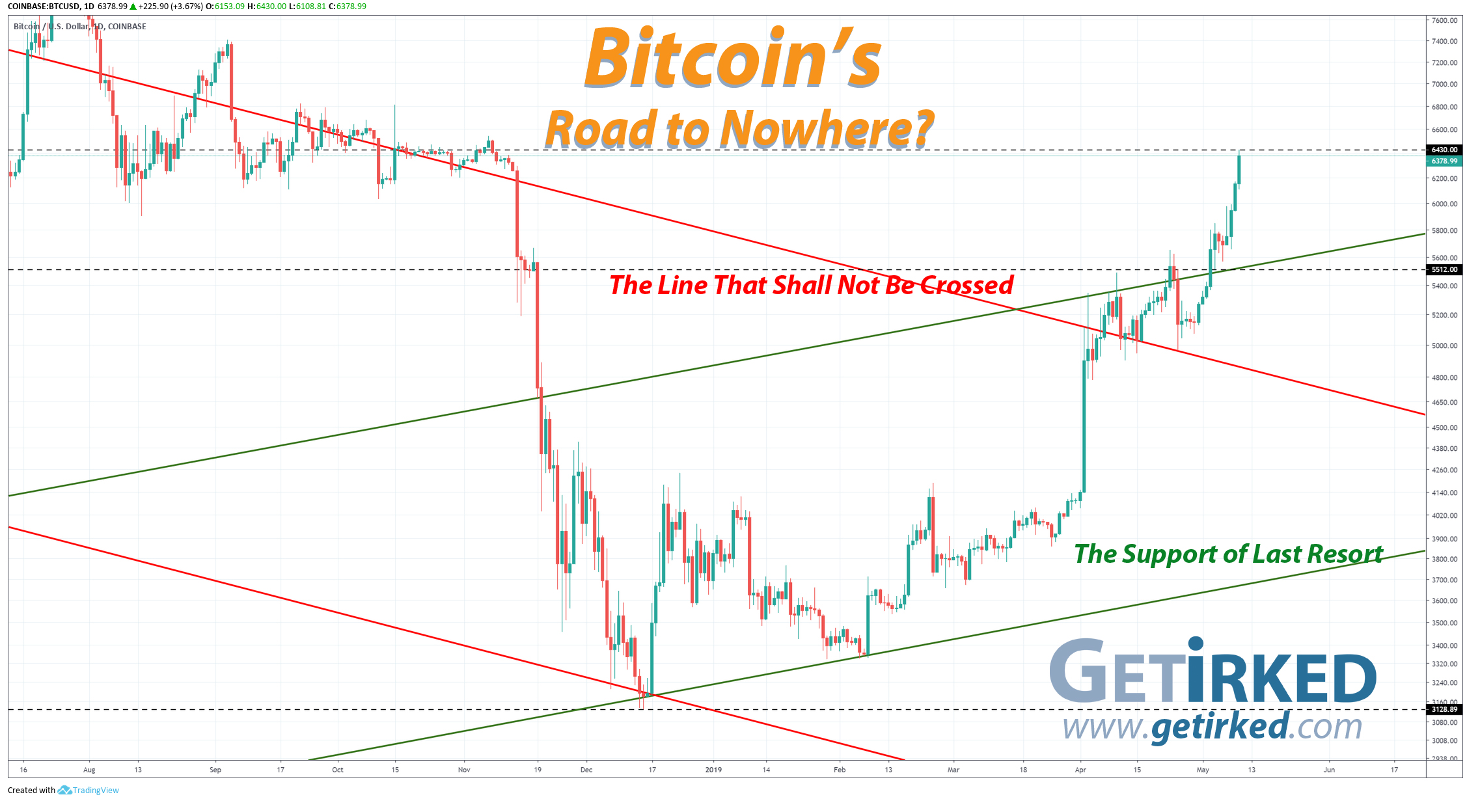Summing Up The Week
How’s everyone feeling? Anyone have the sense of deja vu like we time-traveled back to the end of 2018? We’re right there with you.
When the markets enter periods of volatility, the feelings can be quite unnerving. However, market selloffs are the best time to revisit your Stock Shopping List and steel yourself against emotion (FOMO can certainly hit when the market heads either direction) by focusing on your time horizon.
If you have cash on the sidelines (and you should), look over the stocks you want to pick up during a selloff and start watching for those prices – maybe even place some limit buy orders.
If you do decide to buy, remember: you will not buy at the lows. Even professional traders will say that buying at the lowest possible price is nearly impossible, and, when it does happen, it’s often by accident. For long-term investors, it’s important to remember: you’re building your position and portfolio for the long term.
Even if a stock’s price drops significantly lower than where you bought, a market-wide selloff means that the drop isn’t specific to your stock. Unlike stock- or sector-specific news where you need to be overly concerned about weakness in your specific company, a market-wide selloff means when the macroeconomic news turns around, your investment will, too.
If you’ve done the due diligence and chose a company with excellent growth prospects and a good track record, you should be fine in the long run. In the meantime, if you can’t think of selloffs as the market having a sale on your favorite stocks, try to avoid checking your portfolio too frequently in order to avoid making rash decisions.
Let’s check out the news that moved the markets this week…
Market News
Trade War: China Backtracks on All Agreements
The week started with a bang on Sunday before even nearing the actual trading week when Trump tweeted that he planned to increase tariffs to 25% on $200 billion of Chinese wares on Friday at 12:01 a.m., reported CNBC.
To make matters worse, President Xi retaliated on Monday by announcing China may skip the trade talks altogether.
If there’s one thing the markets hate more than negative news, it’s not knowing anything – and the markets are back in uncertain waters when it comes to the U.S.-China Trade Talks.
With only the Fed and China propping up the market’s exuberant froth, the unexpected news caused the Dow to sell off 350 points during Monday morning trading, however the markets turned around and completely swallowed the loss by the end of the day.
Why? What changed?
By the time mid-day trading hit, many analysts started to theorize that Trump was simply using a negotiation tactic. China even officially announced that this week’s meeting was indeed still on and the bull market returned… or so we thought.
After the bell on Monday, members of the Trump administration made remarks indicating the China trade news was worse than initially thought, going so far as to suggest that China had backpedaled on agreements the U.S. thought were in place. This news resulted in a massive sell-off during Tuesday trading with the Dow down nearly 500 points at its low with the S&P 500 down -1.70% at its daily low.
On Wednesday morning, the news broke that China had indeed sent a diplomatic cable late last week backtracking on all of the agreements placed during trade negotiations, reported CNBC. From what the reports said, China reignited the Trade War.
Wednesday evening, Trump announced China “broke the deal” during a speech, reported CNBC, further magnifying the sell-off into Thursday trading.
The tariffs – an additional $200 billion of costs for American consumers – will no doubt slow the global economy as consumers will slow their buying to accommodate the higher prices of goods they’ve come to expect from China.
With no agreements Thursday, the tariffs went into effect at 12:01 a.m. Friday with Trump tweeting “No need to rush” going into Friday’s trading and Uber’s IPO.
Friday’s trading continued downward to the point of Dow having a 358-point loss, until CNBC reported that Treasury Secretary Steve Mnuchin described the trade talks as “constructive,” causing the Dow to rebound from its low to finish the day positive!
Man, what a week!
The one we’ve all been waiting for – Uber’s IPO
Whether you’ve been excited to pick up some shares or terrified of what it will do to the market when it sucks all the oxygen out of the room, Uber’s (UBER) $80 billion Initial Public Offering (IPO) on Friday signified a milestone in the markets.
The last few months have been marked by the return of IPOs. From high-flying insanity coming from Beyond Meat (BYND) and Zoom Technologies (ZM) providing doubles, triples and more to disappointments like Lyft (LYFT) collapsing more than 40% from its highs, there’s no question that nothing adds spice to a market like some freshly-cut IPO action.
Uber has been the big daddy. Not a new company, Uber has been losing BILLIONS of dollars each year as it tries to compete in the still-new ridesharing sector. Offering more than ride-sharing with its Uber Eats food delivery service and Uber Freight trucking & logistics management platform, Uber has been a long-awaited IPO.
Well, if you’re a company going public, you typically want to do it during a bull market and preferably on an up-day. Obviously, that wasn’t going to happen for Uber with the China trade deal news causing the markets to experience volatility not seen since the Bear Market sell-off in December 2018.
To make matters worse, Uber’s competitor, Lyft (LYFT), has bombed since its IPO, dropping more than 35% from its opening bid to a low of $50.02.
So, how’d Uber do?
In a few words – not good. In a few more – really, really not good.
Uber announced its IPO price at $45 on Thursday evening. It opened trading on Friday at $42.00 – down $3 – and then went further down from there making a low of $41.09.
Later in the morning, Uber rebounded and appeared to gain ground, touching $44.85 a few times before collapsing under its own weight once again, closing the day at $41.41, a loss of -7.98% from its $45 IPO price. Ouch!
Just for background, IPOs are designed to make profits for investors who get in on the deal before the stock hits the open market. The fact that the opposite happened and pre-IPO investors lost money does not bode well for Uber’s prospects or the prospects of the entire ride-sharing space, for that matter.
What does Get Irked think of Ride-Sharing?
Our perspective is the premise that the entire world’s population will get rid of their own cars to borrow others isn’t going to come to fruition, and, unfortunately, that bizarre concept is the only outcome that will lead either Uber or Lyft to actually turning a profit.
We believe Uber and Lyft are a new form of taxi service. They have the capability to fully replace taxis and potentially all of public transportation in its current form.
However, for people who don’t reside in major metropolitan areas, ride-sharing will be used as an infrequent but convenient alternative to taxis when their own car won’t do the job such as going out for a Friday night to have a few drinks.
Another key element ride-sharing’s hopeful optimism also overlooks is that some of us (Get Irked included) actually enjoy driving. Not only do we like having the freedom owning our own vehicle gives us, we actually enjoy the act of operating the vehicle.
We don’t see both Uber and Lyft going out of business, although the possibility for at least one of them to go under is very high. We just don’t agree that their company valuations should be considered remotely reasonable since the basic premise leading to the eventual domination of ride-sharing is fundamentally flawed.
Next Week’s Gameplan
Negative catalysts like this week’s trade war news are the reasons we spend so much time preparing a Stock Shopping List and targeting Buying Stages.
Now comes the hard part – executing the plan. We often find it difficult to overcome emotion and place orders in the heat of the moment, so we review our gameplan and place Good-Till-Canceled (GTC) Limit Buy Orders in advance, sometimes several days or even weeks in advance, in fact.
Limit Buy Orders are orders to purchase shares of a stock or index fund at a certain price or lower. Unlike Market Orders which fill immediately at the current price, limit orders will not fill unless the investment in question reaches the price the investor places.
The downside to limit orders? Sometimes the stock or ETF doesn’t drop to the price set in the order so the order doesn’t fill. However, discovering that the investment has bottomed and is now headed higher is a high-quality problem.
If you haven’t had a chance to put money to work, your opportunity may be coming, however remember to Buy in Stages, keeping cash on the sidelines to buy more if the market heads lower than you initially expected. By the way, if you do have cash on the sidelines and have been looking for ways to make some risk-free returns while you wait, check out our new feature story from earlier this week: “How can you make money from your cash?“
Economist John Maynard Keynes has an appropriate quote for the unexpected actions of the stock market: “The market can stay irrational longer than you can stay solvent.”
In other words, the market often finds ways to push higher than we think should be possible or drop lower than we could imagine. It can be almost impossible to be prepared for any eventuality, however, every investor should try and make their investment plan fit any scenario – no matter how crazy the scenario may seem.
This Week in Play
Stay tuned for this week’s episodes of our Investments in Play and Trades in Play coming online later this weekend!
Get Irked in your Email?
We’re making a list and checking it twice! If there’s enough interest, we’ll start sending the Week in Review straight to your inbox!
Interested? Click here to sign up!
Crytpo Corner
Bitcoin Price (in USD)
%
Weekly Change
Bitcoin Price Action
Bitcoin continued to push higher this week, crossing through the $6,000 mark and making a new 2019 high of $6430.00 with a new weekly low of $5512.00.
Crypto in the News
Binance Hacked for $41M in Bitcoin
On Tuesday, Binance announced that it had lost $41 million USD worth of Bitcoin thanks to a hack of their system, according to Wired Magazine. The hack is the 6th largest in cryptocurrency’s rocky history and continues to demonstrate one of the weaknesses of an anonymous payment system – if you get hacked, you likely won’t get it back.
Bitcoin Gameplan
Bitcoin’s attempt to return to greatness has truly been epic, however, it’s worth remembering that 30%-40% (and greater) pullbacks are commonplace in the crypto space, even in the big daddy of them all, Bitcoin.
Compound Bitcoin’s overbought conditions this with the horrendous U.S.-China Trade War news from this week and you’ve created a recipe for some seriously spicy trading action throughout the crypto space.
Many crypto pundits claim the sector remains independent and non-correlated to the rest of the world economy, however the Bear Market of 2018 in stocks and equities saw a direct correlation to crypto when Bitcoin lost more than 50% of its value during the same time period from November 6 – December 15.
Given this historical price action, we’re still closely watching the crypto space, but we’re also in no hurry to enter any orders until we see Bitcoin drop to lower levels in order to cool off its current overbought Relative Strength Index (RSI) rating.


